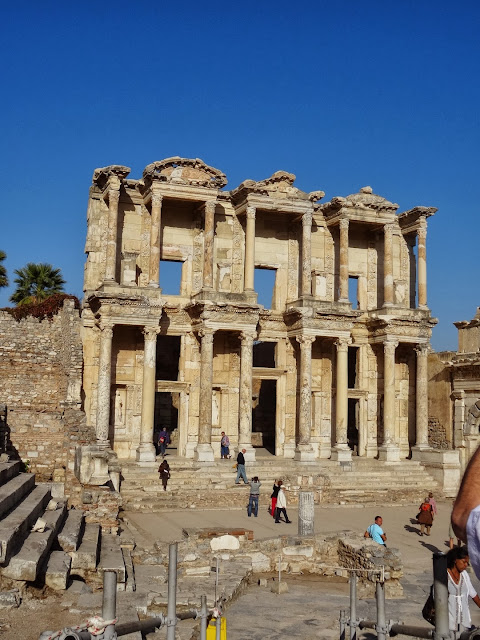Today we went to the ancient city of Ephesus. Welcome to Turkey. We do not expect to see as much development here.
We went off via the gangways, onto waiting buses, all 1000 passengers! Very impressive organisation by cruise staff, with a minimum of waiting time and fuss.
In Turkey, agriculture is fairly big industry including citrus, olives, and also cotton production. There are also horses, goats, cows and sheep, but not much pork as the country while secular, is mostly Muslim.
Ephesus was founded by the Greek prince Androclus, on the site of the Oracle of Delphi, ?myth or legend, 3000 years ago, the Hittites were among the original inhabitants of the site. Ephesus was originally a port town however the harbour eventually silted up, this led to a malaria outbreak, many perished and the city was eventually abandoned.
This is an example of the Roman built baths, with a sophisticated series of rooms designed for the process of bathing as you did then. Ephesus had an advanced aqueduct system with terracotta pipes carrying water where it needed to go. Another advanced thing was dumb waiters in restaurants.
Here you can see the original marble street, which have grooves cut into them to prevent slipping.
St Paul made three visits to Ephesus, and preached in many places during his time there. This monument, the Nymphaem Traiani has links to Paul, which I would need to research for facts. The round marble figure resting on the table, suggests the ancient Greeks knew the world was round.
Hadrian keeps popping up in this trip and this is his temple.
Here are public toilets only for men. Built out of marble, a little bit cold as you can imagine, not to worry. They had slaves whose job it was to warm the seats by sitting on them themselves. These toilets had a flushing system, and also music to drown out those unpleasant toileting sounds.
Next along the road we came to the terrace houses. These were residences built into the slope of the hill and were an ancient times block of units. Terrace 1 for example, was a group of 6 unit houses built around a central courtyard area. Inside, they were decorated with frescoes, so named because the paint was applied while the plaster was wet, and had complex mosaics on the floors.
Local marble on the walls, and the central courtyard, with a altar in it.
More quilt inspiration.

The ladies room.
More amazing mosaics, which were in many rooms.
Moving on from the houses we came to the ruins of the Library of Celsus which is the third oldest building, built in 200 BC.
This is a processional way where Marc Antony and Cleopatra are said to have processed.
This is the Grand theatre built in third century BC. The Romans enlarged and modernised during their time there. There was a 25,000 seat capacity, the stage building was three stories, and 18 metres high.
This was on our way to Turkmans carpets on the outskirts of Kusadasi.
We were able to watch a demonstration on the double knot technique they use when making the carpets out of wool, or silk as in the picture above.
And then how tempting to buy one, shipping is free as it is a trade supported by the Turkish government., but which one do you choose?
Then back to the ship for some more R and R.
Not too much time to rest however as back on an excursion to Patmos, this time instead of the gangway, we were ferried across on tender boats, yes another boat! These boats just parked alongside the cruise ship and you went down via some steps.
The Monastary of St John is in a fortress like building. It is a Greek Orthodox, founded in 1088 in Chora, located next to the Grotto where St John is said to have had his visions and God spoke to him, and he wrote the Book of the Revelations. There is much history here, ST John is said to have been extremely old at his death, 95-104, depending on who you talk to, and he spent his last years in exile here from the age of 75.
We could not take photos inside, but could take photos of these ancient frescoes and mosaics
which give you some of the idea of what it was like inside.
Inside the museum there were many icons and ancient manuscripts written by hand onto parchment of lamb or goatskin.
Further down the hill, was the Grotto of St John, and Chapel of Anna built into the rock. It was essentially a big cave, high enough to stand up in. There was a ledge on which the scribe wrote down what St John was dictating, and also a niche in the rock where John would lay down his head on the rock pillow to rest. Beside this was a handgrip which John would use to pull himself up after praying and meditating. Up above there are three fault lines in the rock through which God's voice is said to have come through telling John what to write.
This is the town centre, where there are shops and cafes.
Back to the Ship....
For some more of this.....



























































